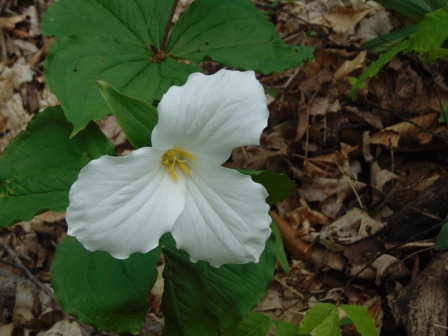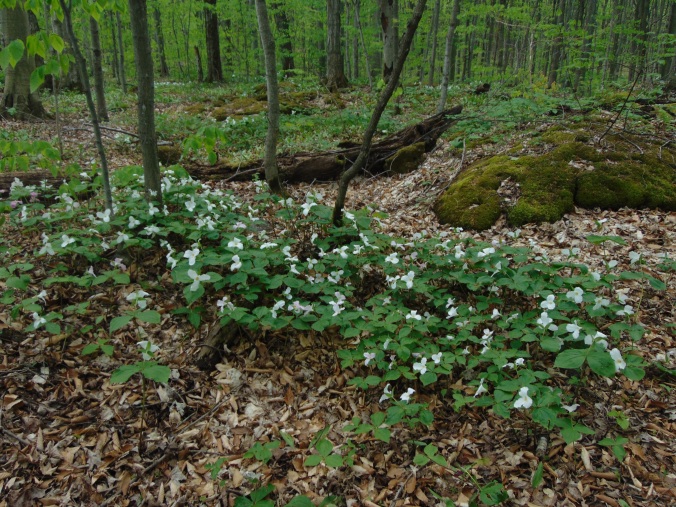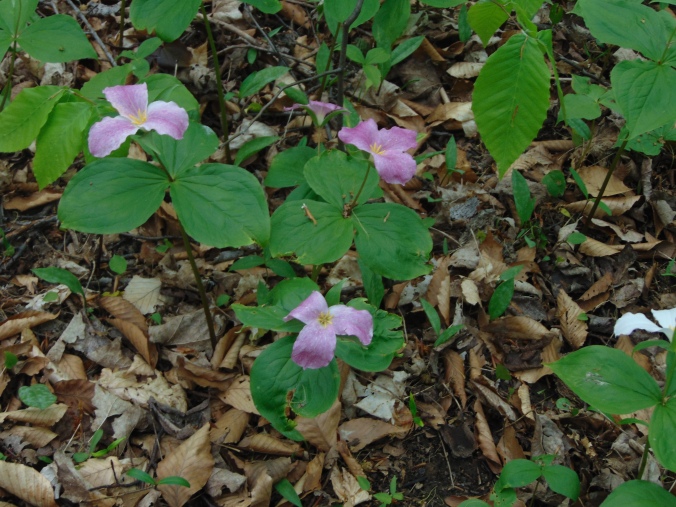
One of the most pleasant, accessible short hikes on Ontario’s famous Bruce Trail begins here, at the end of Cathedral Drive in Hope Ness, on the Bruce Peninsula. And right at the end of my driveway too, by the way.
Depending how leisurely you want to walk, Hope Bay is more or less a two-hour hike south. Or, conversely, a two-hour hike north from Hope Bay to this point.
If you start here, about 15 minutes in you’ll want to take a side trail to the cliff edge overlooking Hope Bay, reaching out in the distance to the broad, blue expanse of Georgian Bay.
I try to walk to the lookout, which I regard as a very special place, at least once a week. A few days ago on the way I saw the trilliums were starting to bloom. But I didn’t have my camera with me. Sometimes I would just as soon let the fleeting moments of natural beauty have their freedom, rather than capture them.

But this morning, to keep a promise, (Hi, Julie) I took a short walk in with my camera to take a few photos of the Province of Ontario’s official flower to post here. Trilliums are mostly white. But I saw quite a few of the rarer, delicately mauve variety.
Not everyone gets to live beside the Hope Bay Forest, so I hope you enjoy these few photos:



This post was definitely not inspired by today’s daily prompt, catapult.
Beautiful!
LikeLike
Thank you
LikeLike
Per our discussion in the grocery store about cowslips. From a now lost link:
“On the
Bruce Peninsula, it
seems to crop up in
old orchards. In one site in
Eastnor Township there is
probably the biggest spread of it
to be found anywhere in the
world! Joe remembers seeing
this stand first in the 1970s.
Since then it has spread until it
now covers several hectares. For
two or three weeks in May it
presents a carpet of deep yellow
blossoms. It appears to have
started in an old orchard, but has
spread into the adjacent meadow
and up along the trail until it
finally peters out where the shade
of the forest becomes too dense
for it. This location fits perfectly
the habitat description found in
Oleg Polunin’s “Flowers of
Europe”: “meadows, pastures,
open woods”.
LikeLike
Thanks, Martin. I’ll have a look for it tomorrow
LikeLike
I have pics but don’t know how to post them here. This is what they look like. They are on th left and opn the trail itself. https://pryorfrancis.files.wordpress.com/2012/04/cowslips-close-up.jpg
More from the link.
“Both the Cowslip and the
Primrose occur throughout much
of Europe except the extreme
southeast, but the Cowslip’s range
extends further north and east into
Scandinavia as far as Finland.
This more northerly range may
account for the Cowslip but not
the Primrose establishing itself in
isolated spots in Canada –
probably escaped by introductions
by homesick gardeners.
The Cowslip also seems to have
established itself in isolated spots
in Canada. Joe Johnson is
familiar with it from Nova Scotia
and it occurs on the Bruce
Peninsula. There is no mention of
it in Newcomb’s “Wildflower
Guide” which seems to indicate
that it is not found in the States to
any extent.
In the United Kingdom it is much
less common than the
Primrose and is
usually found in
small groups on the
edge of meadows.
Joe Johnson recalls a
similar distribution in
Nova Scotia.”
It is all over the place in the township but especially past your place. On the left in the field and on the trail itself. From another link:
“I ran into another example a year or so ago, in the spring,
when I was chatting to someone on the beach at Hope
Bay. We had just been up to the Jack Poste Loop on the
Bruce Trail where you park near Hopeness. I remarked on
the wonderful display of Cowslips, far more than I have
ever seen in one place in England. He did not seem very
impressed and said there were lots of them where he lived
in Strathroy. It did not dawn on me until some time later
that he was talking about Marsh Marigolds (Caltha
palustris) and I was talking about the European
introduction, Primula vera. Early settlers moved common
names across the ocean the way they moved place names.
I grew up near Woodford, and Epping was a few miles
away through the forest. That Woodford and Epping were
on the edge of London, not in Grey County!”
LikeLike
Ah, yes. I see by your pic link that what I called Dutchmen’s britches are Cowslips. What I call them maybe goes back many years to a local friend, Wilma Butchart, who used to live where I am now. There’s lots of them on the property.
LikeLike
Any idea what the red markings on at least one tree and red ribbons back there on the Jack Post trail are all about? About 500 yards in.
LikeLike